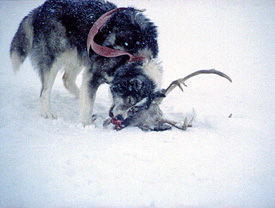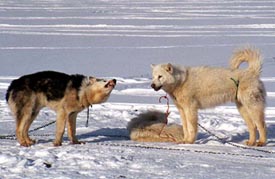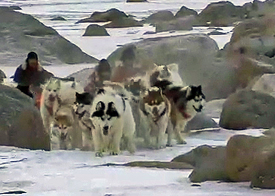Defining
the Inuit Dog
Canis familiaris borealis
by Sue Hamilton
Canis familiaris borealis
by Sue Hamilton
© December 2011, The
Fan Hitch, all rights reserved
revised: December 2020
revised: December 2020
A.
The
Inuit Dog’s place in the natural world
B. The Inuit Dog is not a wolf!
C. Dangerous confusion
B. The Inuit Dog is not a wolf!
C. Dangerous confusion
A. The Name Controversy
B. Defining 'Purity'
C. Mistaken Identity: Promoting a breed vs. avoiding
extinction
D. The Belyaev Experiment
E. Summary
B. Defining 'Purity'
C. Mistaken Identity: Promoting a breed vs. avoiding
extinction
D. The Belyaev Experiment
E. Summary
A. Ancient
history
B. Recent history: The Inuit Dog in service to nations
B. Recent history: The Inuit Dog in service to nations
1. Exploration
2. War
3. Sovereignty
2. War
3. Sovereignty
C.
Population
decline
A. In the North
B. Below the tree line
B. Below the tree line
A.
Inherited
diseases
B. Disease prevention and access to veterinary services
B. Disease prevention and access to veterinary services
A.
Appearance
B. Behavior
C. Performance
D. The big picture
VII. The Inuit Dog in
Scientific Research, Films andB. Behavior
C. Performance
D. The big picture
in Print
VIII. Acknowledgements
Appendix 1: Partial list of scientific publications about
the Inuit Dog
Appendix 2: Selected (alphabetical) list of other resources
with a focus on Inuit Dogs
Appendix 3: A small sampling of other resources of
interest
Navigating This Site
Index of articles by subject
Index of back issues by volume number
Search The Fan Hitch
Articles to download and print
Defining the Inuit Dog
Ordering Ken MacRury's Thesis
Our comprehensive list of resources
About The Fan Hitch
Talk to The Fan Hitch
The Fan Hitch home page
Editor-in-Chief: Sue Hamilton
Webmaster: Mark Hamilton
The Fan Hitch,
Journal of the Inuit Sled Dog, is published
four times a year. It is available at no
cost online at: https://thefanhitch.org.
The Fan Hitch welcomes your letters, stories, comments and suggestions. The editorial staff reserves the right to edit submissions used for publication.
Contents of The Fan Hitch are protected by international copyright laws. No photo, drawing or text may be reproduced in any form without written consent. Webmasters please note: written consent is necessary before linking this site to yours! Please forward requests to Sue Hamilton, 55 Town Line Rd., Harwinton, Connecticut 06791, USA or mail@thefanhitch.org
This site is dedicated to the Inuit Dog as well as related Inuit culture and traditions. It is also home to The Fan Hitch, Journal of the Inuit Sled Dog.
The Fan Hitch welcomes your letters, stories, comments and suggestions. The editorial staff reserves the right to edit submissions used for publication.
Contents of The Fan Hitch are protected by international copyright laws. No photo, drawing or text may be reproduced in any form without written consent. Webmasters please note: written consent is necessary before linking this site to yours! Please forward requests to Sue Hamilton, 55 Town Line Rd., Harwinton, Connecticut 06791, USA or mail@thefanhitch.org
This site is dedicated to the Inuit Dog as well as related Inuit culture and traditions. It is also home to The Fan Hitch, Journal of the Inuit Sled Dog.
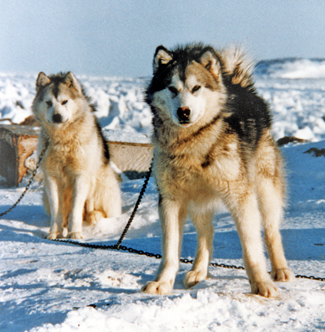 Inuit Dogs in
Iqaluit, NWT (now Nunavut) around 1990.
Photo: Cees Ingwersen VI. Describing the
Inuit Dog
A. Appearance The aboriginal Inuit Dog has no
official written standard as do cultured breeds
registered by organizations such as the AKC, CKC
and FCI. The superficial appearance of landrace
dogs is not dissected and scored body part by
body part. The breeding of Inuit Dogs has been
focused on stamina and performance. Lifestyle
and harsh polar conditions shaped this landrace
by its use and survival of the fittest. In his
December 2006 article in The Fan Hitch
Journal Mark Brazeau of
Kangiqsualujjuaq, Nunavik interviewed community
Elders Johnny-George Annanack and Tivi Etok to
get their recollections describing the authentic
Inuit Dog that had been absent from Nunavik for
many decades.
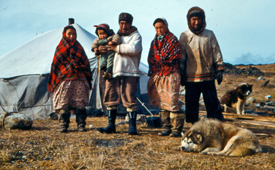 A family in Nunavik 1956 Photo: Luc Boyer The individual variation of
aboriginal dogs within a single population is much
wider than would be allowed in a cultured breed.
Variation in the appearance of any landrace in its authentic condition far exceeds what is considered acceptable in a cultured show breed. When an aboriginal dog becomes designated as a pure breed in order to be "saved from extinction", the same mistake is made repeatedly: one type, which seems most frequent or most attractive, is selected and the rest of the pre-existing variation is purged. Native people do not care about details of the appearance of their dogs, but pay much more attention to their working ability. Especially in the old days, in every community variation among dogs was maintained by exchange of dogs during travels and trading. This is why aboriginal dogs of the same nomadic camp or a village have less uniform appearance then pedigreed breeds do. Vladimir
Beregovoy, PhD.
Evolutionary Changes in Domesticated Dogs: The Broken Covenant of the Wild, Part 2 The Fan Hitch Journal, V11, N3, June 2009 Yet there are some
generalizations that can be made: 1
Four days old. Photo: S.L. Han
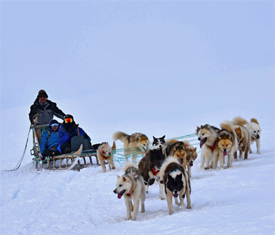 On the way
back from Ammassalik Fjord are in
the fog;
East Greenland April 2017. Photo: Giulia Morosetti,
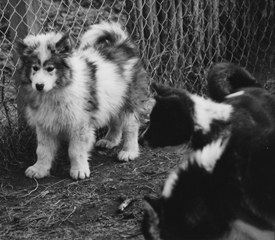 White and grey merkuiuq pup with normal coated littermates. Photo: Hamilton
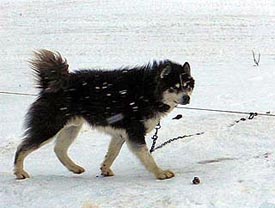 Photo: Hamilton In addition to genetic
influence, the Inuit Dog’s size is a function of
its environment and use. Prior to access to
firearms at which point food was easier to
harvest, the population of dogs of the Inuit was
lower and their physical size likely smaller,
based on accessibility of food resources
(pre-Thule period)2.
Not only did the quantity and quality of diet
impact on a dog’s size, its lifestyle did as
well. Dogs that performed work every day had
more well-defined and developed muscles.
Males are reported to be
significantly larger in weight, height and
broader in body and bone thickness than females.
According to MacRury, comparative weights and
heights are as follows1:
Inuit Dogs brought out of the arctic as puppies and adults, living in this author's kennel range in size as follows:
B. Behavior
The behavioral profile of the
Inuit Dog is the result of millennia of a
working life in harsh arctic conditions. In very
early times, the dogs were not confined, instead
being allowed to roam outpost camps socializing
with humans of all ages as well as with their
own species. When the dogs were not working in
some capacity (not just pulling sledges) for
humans they were usually left to forage for
their own food. So predatory-aggressive behavior
was not only a result of their partnership with
a hunting society in the acquisition of animals
as food and other raw materials, but also for
their own survival when not being fed directly
by humans.
Within this historically
early, free-ranging Inuit Dog society, pack
dynamics were established. There existed an
alpha dog, also identified as a "king" dog or
"boss" dog.3
A
competent, intelligent boss dog was the one
who ruled supremely, generally kept the peace
among lower ranking dogs, ate first and most,
and was the male who mated with the bitches. A
good boss seldom fought to injure or kill,
unless the lower ranking dog for some reason
failed to accept the boss's authority or
decided to challenge it. Where the boss was
old and failing, he would be killed by the
younger, stronger rival. This is an example of
the ISD’s social-aggressive behavior.
Part of the Inuit Dog's survival success has resulted in an animal with a well-developed sense of pack social structure, an animal who is acutely aware of the hazards and opportunities of its environment and an ability to communicate its feelings and intentions and in a manner far more directly than cultured breeds. It is also adept at reading body language signals of other dogs and humans to a greater degree than dogs bred as pets and show dogs. The following four images and captions, contributed by behavioural biologist Giulia Morosetti, describe her observations of the evolution of a fight among a team of Inuit Dogs she witnessed first-hand in the Kulusuk area of East Greenland, March 2017. (In 2020 Dr. Morosetti completed her veterinary masters degree “I cani da slitta indigeni dell’Arctico: Simbolo dell’identità dei loro popoli e patrimonia dell’umanità”/“The indigenous sled dogs of the Arctic: Symbols of the identity of their populations and patrimonies of humanity”).
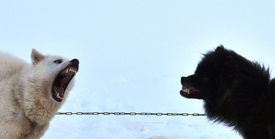 The whitish
and the black dogs from this team were not
getting
along well in general. Probably it was wrong to keep them picketed next to each other, so that they never had a real possibility to define their positions, thus becoming more and more frustrated. 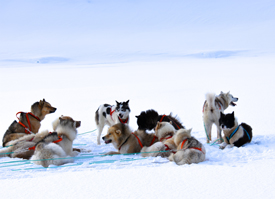 Two males instigated the fight on this team. At the beginning everything looked calm, but already two dogs were exchanging messages. 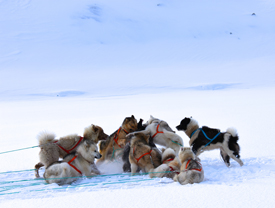 Suddenly the black dog which is hidden behind the boss, did something wrong and was immediately punished by two other males, especially the whitish dog. The boss dog intervened later to settle the fight.
All dogs benefit from early
socialization. But for aboriginal dogs in
general and Inuit Dogs in particular, human
contact right from birth is considered essential
to establish a useful bond between working dog,
master and other humans. Fear aggression in
Inuit Dogs has been described since old times in
animals that have not had adequate early and
continuing human contact. Properly raised, the
Inuit Dog is generally very social to humans,
however that should not be confused with "pet"
behavior as these dogs are selected for
reproduction based on working performance and
everything that encompasses, not based on a
"soft" temperament.
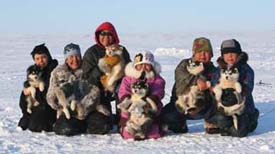 Photo: Lee Narraway
This is the working animal of
the circumpolar North, where its behavior is
well known and understood, and where the dog has
evolved, where it needs to be fine-tuned by
nature and work, to survive as an aboriginal
dog. Renee Wissink, who, with four other men and
46 Inuit Dogs, recreated the 1832 migration of
the shaman Qitdlarssuaq,
traveling 1800 miles in about three months from
Igluliq in the central Canadian High Arctic to
the northwest coast of Greenland, described the
Inuit Dog from its point of view: "If you can't eat
it, or screw it, then piss on it!"
This landrace exists below the tree line, too, found on recreational teams as well as those of commercial outfitters who understand, value and respect them. Owners who keep and or use cultured breeds of sled dogs who are only vaguely familiar with the Inuit Dog often describe them as "alligators with fur". These people, and the outside-of the-arctic dog owning population at large, have no understanding or appreciation of the nature of aboriginal dogs. Mushers who use other breeds (and mixes) of sled dogs have openly questioned the "need" for Inuit Dogs to retain their "aggressive tendencies", observing, "They don't hunt polar bears or fend for themselves anymore." This uninformed attitude, this desire to dissect out parts of a dog's profile as a matter of convenience to suit the desires of a foreign culture in a foreign land is the mind-set of what has transformed so many formerly functional working dogs into scores of useless cultured breeds, a practice begun in earnest in Victorian England. With attitudes like these, the responsible ownership and use of Inuit Dogs outside their native habitat can be challenging. Mother (l) explodes in fury at something her son (r) did to offend her. Photo: Hamilton Considering
the Inuit Dog's history, it is most important
to remember the following quote from Bill
Carpenter, co-founder of the Eskimo Dog
Recovery Project (see
II B):
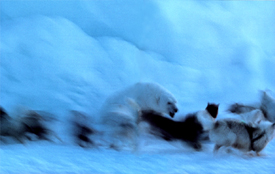 A team of dogs, disconnected from the qamutiq by the hunter, surround and harass this bear while the hunter rushes to join them. Photo: courtesy of Ivar Silis Around
the world the Inuit Dog is thought of
only as a sled dog, as one of its common
designations (Inuit Sled Dog) implies.
But historically there was a period of
time (See III A)
when the dogs of ancient Inuit were not
used principally as sledge haulers.
Prior to the end of the nomadic society
(mid-20th century), the complete, fully
functioning Inuit Dog was still a pack
animal, a hunting partner using both
sight and smell, capable of cornering
and attacking wounded polar bear and
musk ox or locating seal breathing holes
and pup dens, often invisible underneath
snow covered sea ice.
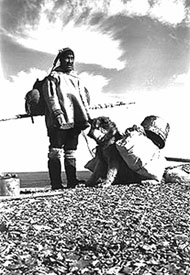 Spence Bay, 1951 Photo: Richard Harrington from Face of the Arctic In harness, the dogs
are able to work under extraordinarily
difficult conditions of dangerous weather,
able to avoid treacherously thin ice, find
the way back to camp in blinding whiteouts,
sometimes doing all of this on very little
food. Physiologically and anatomically the
dogs are able to survive at extremely low
temperatures and have the remarkable ability
to perform well when fed on an irregular
basis, which was and still is not uncommon.
They also quickly recovered from those
periods of starvation once food was
plentiful. Recently physiologists
studied the Greenland
Dog to learn why they could so quickly
return to high performance levels after long
periods of inactivity4
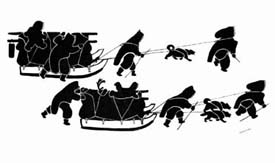 Family Travel block print by Ekootak from I, Nuligak For outsiders who came to the North to explore and claim real estate for their homelands, dogs of the Inuit were the only choice for travel. However, the aboriginal Inuit Dog has been the preferred choice of more recent polar explorer/ adventures as well. And at the other end of the Earth when Europeans, Australians and New Zealanders began to establish Antarctic bases, once again Inuit Dogs from Greenland and eastern Canada were preferred over other breeds because of the Inuit Dog's legendary reputation for its skills in harness: its endurance, willingness to traverse endless fields of pack ice, hauling heavily laden qamutiit (sledges) up and over towering slabs of pressure ridges, on the move hour after hour, day after day sometimes on less than ideal rations. These dog drivers may have complained about the dogs' belligerent displays, but they also all put their faith and their survival in their Inuit Dogs. 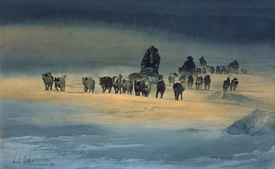 Setting out from Point Barrow. Painting by Sir Wally Herbert depicting the 1968 beginning of his British Trans-Arctic Expedition: four men and forty Inuit Dogs crossing the sea ice via the North Pole in sixteen months, from Barrow, Alaska to Svalbard. Courtesy of Kari Herbert, Polarworld D. The big picture The
Inuit Dog is defined in ways mere words can't
adequately quantify!
The aboriginal Inuit Dog is characterized less by outward appearance than by a host of other functional attributes, including some driven by cellular biology, which have enabled this landrace to survive and thrive as a valued and essential partner to human endeavors in one of the most extreme and violent natural environments on Earth. Thousands of years in the circumpolar north have created an animal that is the sum of many parts. Today few arctic Inuit Dogs live as their ancestors did - packing, hauling and hunting for most days of the polar year. The transition was from a free ranging life in traditional seasonally relocating outpost camps to picket lines within settlements. An increasing dependence on a wage earning economy meant a greater reliance on snow machines to quickly take families out on the land to hunt and fish during the limited non-work time. 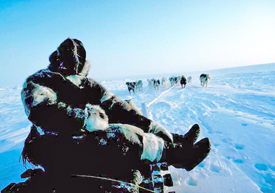 Photo: courtesy Nunavut Tourism 1 Based
on a total of 499 dogs from Canada and Alaska;
from The Inuit Dog: Its
Provenance, Environment and History
by Ian Kenneth MacRury; Featured
Inuit Dog Owner: Ken MacRury, The Fan Hitch,
V5N4, September 2003; personal communication with
Mr. MacRury.
2 “In most area of the Eastern Arctic, around Baffin Island and into Hudson Bay, firearms were introduced to the Inuit in the mid to late 1800s by the whalers. However due to the uncertainty of ammunition supply the widespread use of firearms was not until the trading posts were established. That mostly happened in the early 1900s. Places like Cape Dorset and Pond Inlet had permanent trading posts by about 1910 while some others like Igloolik were not established until the 1930s. In the central arctic the regular use of firearms was even later, likely not until the 1940s in some of the more isolated areas.” Personal communication with Ken MacRury. 3"Boss Dogs and Lead Dogs: Are They Born or Made?" by Ken MacRury; The Fan Hitch, V12N1, December 2009 4 Muscle plasticity of Inuit sled dogs in Greenland; Nadine Gerth, Steffen Sum, Sue Jackson and J. Matthias Starck; The Journal of Experimental Biology 212, 1131-1139, 2009 |
